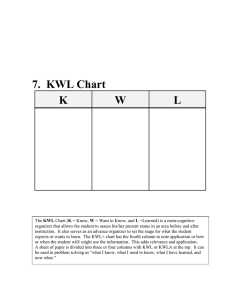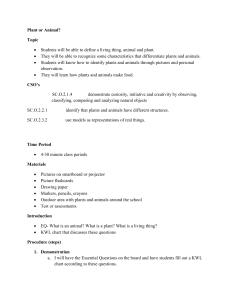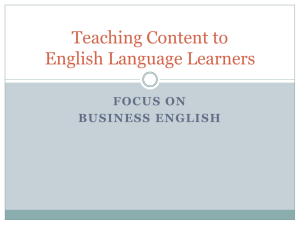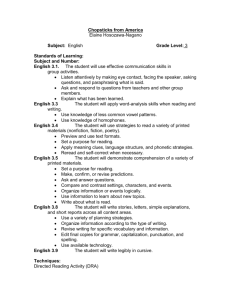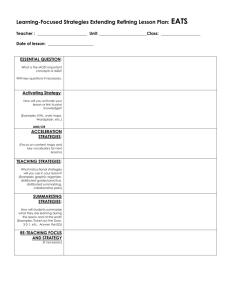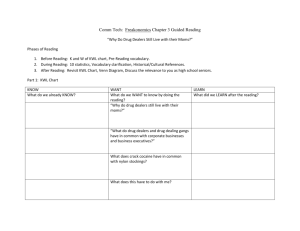Secondary Music Reading Strategies
advertisement
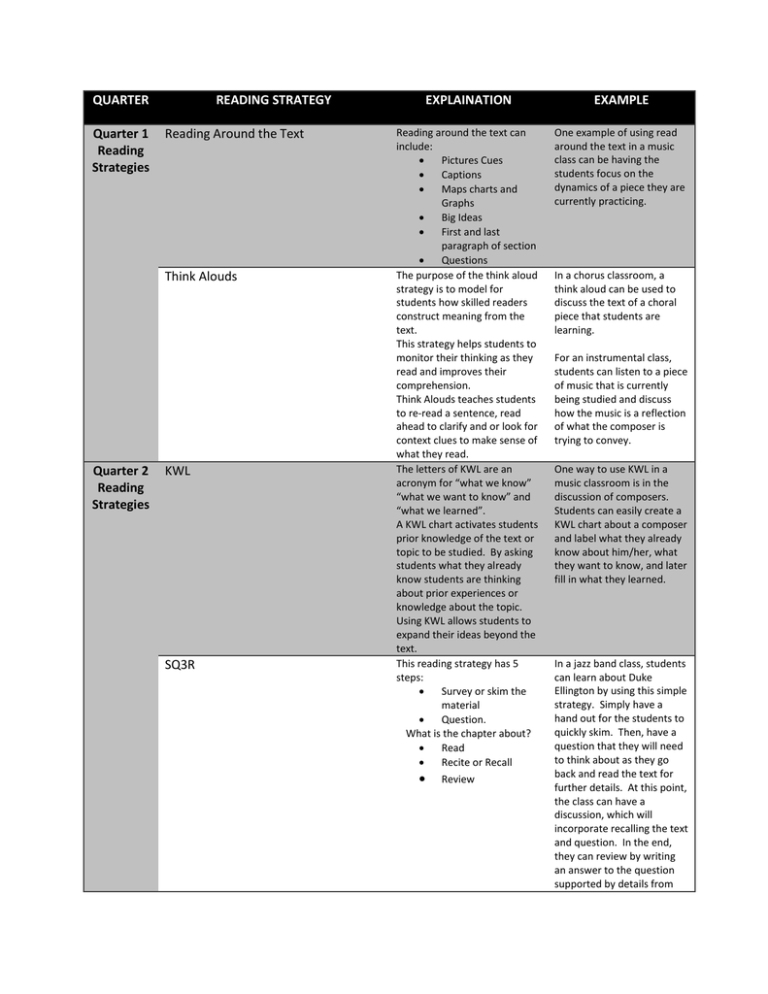
QUARTER Quarter 1 Reading Strategies READING STRATEGY Reading Around the Text Think Alouds Quarter 2 Reading Strategies KWL SQ3R EXPLAINATION EXAMPLE Reading around the text can include: Pictures Cues Captions Maps charts and Graphs Big Ideas First and last paragraph of section Questions The purpose of the think aloud strategy is to model for students how skilled readers construct meaning from the text. This strategy helps students to monitor their thinking as they read and improves their comprehension. Think Alouds teaches students to re-read a sentence, read ahead to clarify and or look for context clues to make sense of what they read. The letters of KWL are an acronym for “what we know” “what we want to know” and “what we learned”. A KWL chart activates students prior knowledge of the text or topic to be studied. By asking students what they already know students are thinking about prior experiences or knowledge about the topic. Using KWL allows students to expand their ideas beyond the text. This reading strategy has 5 steps: Survey or skim the material Question. What is the chapter about? Read Recite or Recall One example of using read around the text in a music class can be having the students focus on the dynamics of a piece they are currently practicing. Review In a chorus classroom, a think aloud can be used to discuss the text of a choral piece that students are learning. For an instrumental class, students can listen to a piece of music that is currently being studied and discuss how the music is a reflection of what the composer is trying to convey. One way to use KWL in a music classroom is in the discussion of composers. Students can easily create a KWL chart about a composer and label what they already know about him/her, what they want to know, and later fill in what they learned. In a jazz band class, students can learn about Duke Ellington by using this simple strategy. Simply have a hand out for the students to quickly skim. Then, have a question that they will need to think about as they go back and read the text for further details. At this point, the class can have a discussion, which will incorporate recalling the text and question. In the end, they can review by writing an answer to the question supported by details from the text. Quarter 3 Reading Strategies Quarter 4 Reading Strategies Venn Diagram This is a simple compare and contrast reading strategy. By using youtube, (or any other multi-media device) you can easily have students compare and contrast musical selections of pieces they are currently studying. Word Walls This is a literary tool composed of an organized collection of words that are displayed in large, visible letters in the classroom. It is designed to be an interactive tool for students to use and contains an array of words that can be used in writing or reading In a beginning band or chorus classroom, it can be useful to have music terms, such as dynamics, posted throughout the room so that the students can use them in every class with a knowledge of what they mean. Reading category 2: Reading application: LA6.1.7.2 The student will analyze the author’s purpose (e.g.: to persuade, inform, entertain, explain) and perspective in a variety of texts and understand how they affect meaning. Students should be able to answer why a composer wrote a specific piece of music. For example, the students could do a study of why the Star Spangled Banner was written by Francis Scott Key. LA6.1.7.5 The student will analyze a variety of text structures (e.g. comparison/contrast, cause/effect, chronological order, argument/support, lists) and text features (main headings with subheadings) and explain their impact on meaning in text. One example of this reading strategy is having students do a compare/contrast exercise of Debussy’s Claire de Lune to Beethoven’s Moonlight Sonata. This can also lead into a discussion of chronological order and defining the musical periods of Romantic and Impressionistic. FCAT 2.0 Question: Author’s Purpose/Perspective Reading category 2 FCAT 2.0 Question Text Structures/Organizational Patterns
